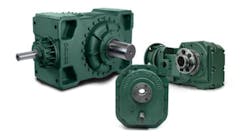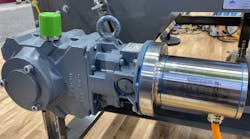How to Choose Multi-Axis Electric Motion Control Technology
TRANSCRIPT
David Greenfield
Welcome to the Automation World Gets Your Questions Answered podcast where we connect with industry experts to get the answers you need about industrial automation technologies. I'm David Greenfield, editor in chief at Automation World. And the question will be answering in this episode is how to choose multi-axis electric motion control technology.
And joining me to answer this question is Anthony Leo with Norgren, a supplier of industrial pneumatic and electric motion control, sensors and actuation technologies. So thanks for joining me today. Anthony.
Anthony Leo
Appreciate it. Thanks for having me on.
David Greenfield
So to start here, Anthony, you know, can you explain what's meant by the term multi-axis electric motion control technology and how does it differ from more general electric motion control and pneumatic motion control technologies?
Anthony Leo
So it's quite simply the ability to combine actuators and a normal single axis into a multi axis way. So you're doing something within a 3D plane and trying to perform a task within that plane. So whether it's a pick and place, material handling, 3D printing, something along those lines with general electric, you have to control and combine multiple motors. Kind of think of like an etch-a-sketch where you kind of turning the knobs in different directions or two different knobs to kind of go in X Y in that example and add a Z to it to go up and down and that's kind of what you're doing to control and combine those multiple motors now to move one spot within that XYZ plane. And so also with electric it's easier to have precision control, generally easier to set up than a pneumatic solution, because you don't need all the error infrastructure available. You're gonna have a little bit less maintenance than some of the traditional pneumatic solutions, whether with the actuators themselves or with the air lines that need to supply the air coming in. So overall, it's also a much greener technology to perform a multi-axis solution on.
David Greenfield
Thanks for clarifying that. So one question I had and you know in thinking about these technologies is multi axis electric motion control suitable for harsh industrial environments or is it more suited for production operations with fewer environmental hazards for electronics?
Anthony Leo
It depends a little bit on the application, so the short answer is it can be. It really depends on the environment and the type of actuator that you do need. So we can add from our side, for example, different additions to a general actuator to make it clean room safe. Maybe an ATEX certification. Do cold room or anti explosion. There's a lot of different things that would add on to say, a traditional actuator to make it suitable for more harsher environments. I mean, we've got into some pretty dusty stuff. So maybe with the dusty environments it might require a little more streamlined design, maybe a cover over some of the components or maybe a method. Sometimes where we add some holes on the side for dust or degree to get kind of pushed out instead of kind of taking up in the corners of actuators. So there's definitely opportunities to do that. When you're talking about full wash down for maybe a food application where you need an IP65 or 69K typically a lot of that can be done with a rod style actuator. So it really just depends on the the application itself. It depends on the type of actuator that might be needed to be able to do something maybe in a little bit harsher of an environment.
David Greenfield
So it's more to your point, it's more about the actuator itself, more so than the multi-axis electric motion control technology itself. So there's ways to adapt the actuation side of it.
Anthony Leo
Yeah. And usually we go through that process with the customers up front when we're we're looking at a system, you know, we'll talk through what the conditions are like, what maybe environmental concerns that may come up in those particular applications. And we'll kind of consider that as we're designing the actuators at that point.
David Greenfield
And what about weight handling? How does that aspect of an application you know figure into the use of multi axis electric motion control technologies?
Anthony Leo
It's it's very important. So we need to understand to size the appropriate actuator and make sure that things are gonna work as the customer expects. We need to calculate the moment loads, the inertia calculations that need to be done to appropriately size it. So obviously the weight for the application and those calculations will drastically affect the performance and the durability of the product. So again, choosing the right option is very important and then depending on if it has an offset load, if you're pushing something or pulling something or simply carrying. That all matters and the design aspect of a multi-axiss or even a single axis electric actuator solution. So again, we typically ask the customers for the application data. We generally do a lot of the calculations for them to size it appropriately, and that way the customer can be certain that the product that they're getting from us is actually going to work for their application instead of them trying to guess—put something in and then a few months later figuring out maybe it was an undersized actuator for the application. So it's pretty important and part of the main process that we go through to figure out the right actuator.
David Greenfield
OK, so a pretty key aspect of the selection process around that.
Anthony Leo
Yeah, absolutely.
David Greenfield
Another aspect, you know I'm wondering about here when it comes to multi-axis electric motion control you know is it better suited for longer distance motion applications or shorter distance applications or does it matter?
Anthony Leo
It really doesn't. The answer is all of the above. So we've gone up to some of our longest applications up to 60 meters so far, which is pretty, pretty long. I guess technically we could go up to 64, but our factory is 64 meters long, so that's the furthest we can go at this point without cutting holes in the wall. So up until that point, but yeah, so we can go pretty long with the electric and we can cut those two exact lengths. But we also have some applications where we're moving maybe 20 millimeters. So really just depends on what the customer needs, but it's a great solution for no matter how long of a distance you have.
David Greenfield
OK. So any plans to cut holes in the wall to go beyond the 64 meters?
Anthony Leo
Not just yet, but if we come to an application that requires it, then maybe so yeah.
David Greenfield
Alright, so you know another characteristic when you're coming to discussions of any discussions of motion control technologies, you know, what about the speed characteristics? How does that figure in with multi axis electric motion control and again, you know in comparison with general electric or pneumatic motion control?
Anthony Leo
Yeah, with electric, you know, for example on our side, we can accelerate up to 10 Gs. So we can move pretty quick and go very fast. It kind of depends on the guide systems and the drive systems that we might put into that particular actuator to get those performance levels, but they have to move very quick. For short movements, pneumatics perform very well and have been used forever for very short, quick actuation, so there's definitely I think more of the positives or the differentiators between the two when it comes to some of the other things such as like I said, the maintenance, the total system cost reduction of having to have the error and all stuff that generally comes into a little bit more of the consideration. But when it comes to the speed characteristics, it probably depends a little bit on the payload and the distance that you're trying to move on. Maybe which one will have a better speed, characteristic or performance between electric and pneumatic? But we definitely have some pretty fast applications that require us to move very long distance that electric performance very well on.
David Greenfield
And kind of as a follow on to that question about speed, it's one that kind of comes in conjunction with it most often that's accuracy. Can you comment on the accuracy of multi axis electric motion control compared with the other technologies we're speaking about?
Anthony Leo
Yeah, and this is probably one of the key reasons why people have been looking at replacing pneumatics with electric, especially when they're designing maybe a new system like an OEM that's building a new system to eventually submit there and customers electric allows for much more precision capabilities than pneumatics since you're basically just driving a motor, whether it's a stepper or different type of motor ours or motor agnostic. So we can pretty much marry up with anything out there, but essentially just driving the motor with a PLC or a simple stepper, whereas with pneumatic, there's a lot more effort and time that goes on the setup process to get pneumatic to go to a specific point and dial that in. And then there's much more maintenance on the back end. Umm, once that system is installed to keep that running properly. If you have a drop in air pressure, you have a seal that starts to wear. The accuracy starts to go away, so that's definitely one of the big reasons for electric compared to pneumatics is the ability to quickly get it exactly where you want it and know that it's going to go back to that same place every single time. Electric is extremely good at that. So again, depending on the guide and the drive sombo, we can even get as much as .02 millimeters plus or minus accuracy. So we can get pretty pretty good accuracy on that.
David Greenfield
OK, alright. And what about energy use? You know is, you know, based on, you know, your experience I guess with Norgren's own testing as well as what you're seeing at customer sites is multi access electric motion control a good choice for energy efficiency compared to the other options?
Anthony Leo
Yep, that's also one of the other bigger reasons why people are looking at electric in general. It's much more energy efficient as a technology and as a system. Again, you don't need to worry about air compressors, leaks throughout the system and the facility air distribution throughout the facility. There is a lot of, especially when you get to some pretty large companies, a lot of costs that comes out, hundreds of thousands of dollars sometimes per year in air leakage that wastes and of costly. If you're running that compressor, that obviously is a lot more energy. So where you simply have an electric actuator with a motor and you essentially just plug it into the wall that power usage is right then on demand. Essentially, use instead of trying to supply it somewhere else through the facility and then arrive to that particular machine. So it's extremely big as a reason why people are leaning towards this way for a more greener technology and also from a system level can make things a little bit easier when you have a machine that has electric and pneumatic components. If you can get rid of or eliminate a lot of that pneumatic stuff and have pure electric actuation and addition to the other things on that particular machine. Now all you’ve gotta do is plug it into a wall and it's also at that point easy to move around the facility of layout plans change or a new machine comes in and you need to move things and you'd have to move all the air lines and stuff. It's simply it's just putting a new electric drop potentially. So there's a lot of benefits on that side too, but it's definitely from a system standpoint, much greener of a technology than, uh, some of the pneumatic counterparts.
David Greenfield
And one following that because you're talking about just moving to another place, I'd take it, take standard voltage, anything special requirements for this or?
Anthony Leo
Nope, nothing special. We can use a lot of different, umm, a voltage requirements depending on the … It's more so depending on the motor that might be driving it, but once we understand that we can actually supply certain motors as well that we can supply with the actuator when we get into some of the IP stuff with the rod style, that will come with the motor to make sure we have that IP rating. But generally, once we understand maybe the OEM or the end customer has a certain motor they want to use, we can size the right adapter. We will at that point know the power requirements for that and everything, so it's it's usually a non issue. We can use anything pretty much.
David Greenfield
OK. Well, thank you again for joining me for this podcast, Anthony, and you know, thanks, of course to all of our listeners, please keep watching this space for more installments of Automation World Gets Your Questions Answered and remember you can find us online at automationworld.com to stay on top of the latest industrial automation technology insights, trends and news.
Companies in this Article

Leaders relevant to this content:



